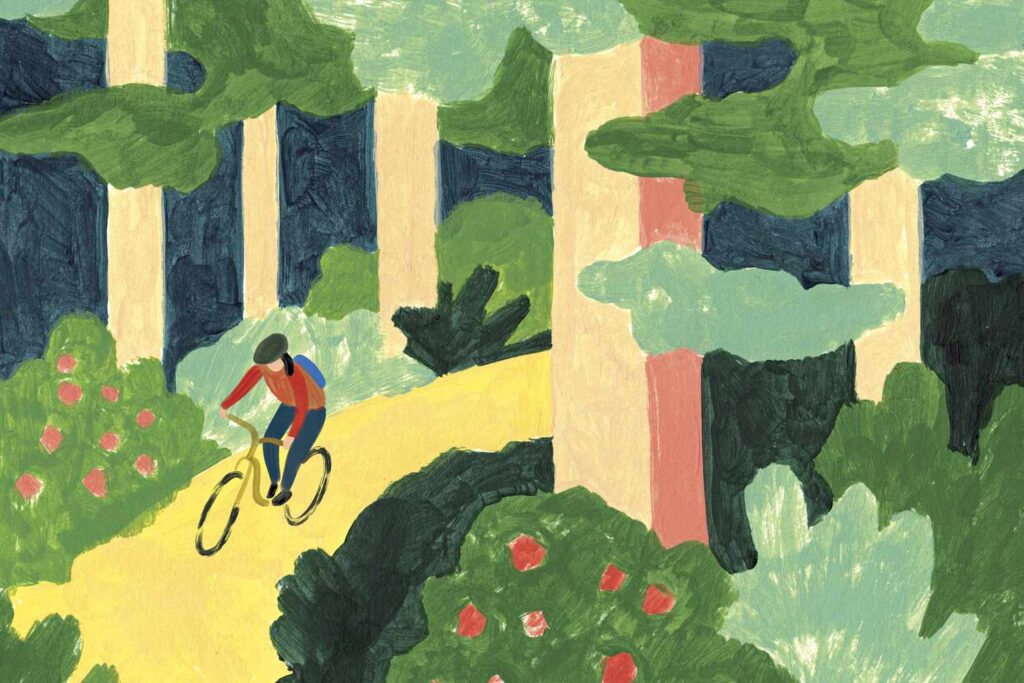Growing up in western North Carolina, in the Qualla Boundary—often referred to as the Cherokee Indian Reservation— was much like growing up in any small, rural mountain town. Every season had its own charm. We caught lightning bugs in the summer, harvested ramps each spring, and ate chestnuts at the Annual Cherokee Indian Fair every fall. In winter, we begged our parents for a sled ride down the Blue Ridge Parkway. My summer break from school was spent tubing down the Oconaluftee River and digging for crawdads in creek rocks.
This area—about an hour west of Asheville, in the Great Smoky Mountains—is also a haven for mountain biking. Although I’ve lived in this area my entire life, it wasn’t until I was in my 30s that I considered wearing a helmet with a visor. I had two kids, and was 60 pounds overweight, miserable at my job, and struggling to publish my first novel. I was also diagnosed with anemia. At the urging of friends, I became motivated to try a new sport (I’d been a longtime basketball player, but my knees couldn’t take it anymore). So, around the same time I started getting regular iron infusions, I took up mountain biking.
At one point, I told a nurse not to worry if my pulse was elevated—I had just gotten off my bike. “Mountain biking? She replied, “That’s so scary.” I scanned the waiting room; most of the patients were hooked up to IV lines and oxygen tubes. Practically every other person was fighting cancer, just as my mother had years ago—before it took her. I couldn’t help thinking: No. What’s frightening?
Many people think of mountain biking as an extreme—and male-dominated—sport, and it certainly can be. It was freedom that made me love mountain biking. I became accustomed to singing glam-metal like Def Leppard’s “Pour Some Sugar on Me”. There was no one around to hear me sing off-key, or erupt in a whoop every now and then.
On the trail I no longer defined myself by my relationships to others, such as being a mother, a teacher, a daughter or if I was married. Instead, I was defined by how much sweat I produced while climbing uphill and how quickly the wind blew against my body when I went down. My favorite place for riding was and still remains, Fire Mountain Trails, A 11-mile system in the town Cherokee. The packed-clay trails wind through a forest of mountain laurel tangled in rhododendrons, which come alive with pastel colours in the spring. Equipped with handlebar lights and a headlamp, I came to love night rides, which often featured sightings of owls swooping for prey.
It was a great blessing to have so many local bike shops and gear shops to assist with repairs, including Industry Nine Cane Creek Motion Makers. Many shops, such as BCOutdoors, Cherokee also offers rentals so visitors can enjoy the trails. When I’m ready to leave, I head to Innovation Brewing, in Sylva, for a beer and food-truck burger, or BCOutdoors, which also has a taproom.
Two women from my school taught me how to ride. Each week we met on the trails to get away from work stress. I learned to value the riding community and made new friends. Modern life’s realities and my own conflicting schedules mean that I often grab a solo ride when I can. A beautiful thing about these trails is that they are safe enough to ride alone, and social enough that you will often run into friends along the way.
Although I enjoy my rides with other cyclists and by myself, I love the ones I share with my sons. Charlie is 12 years old and Ross is 16 years old. I get nervous when they have to navigate along a rocky edge. When they scream in delight when they catch some air, it reminds me of how I felt the first time I rode a mountain bicycle. To hear my son shout, “This is awesome, Mom!” The trails are a gift to the world.
Mountain biking isn’t as scary as I thought. Extreme is the right word. Extreme joy. Extreme living. It’s extreme enough for me to hurl myself down a hill, lose some control, then dust myself off and continue on.
The original version of this article appeared in the June 20,25 issue of Travel + Leisure Ride like the Wind.”


